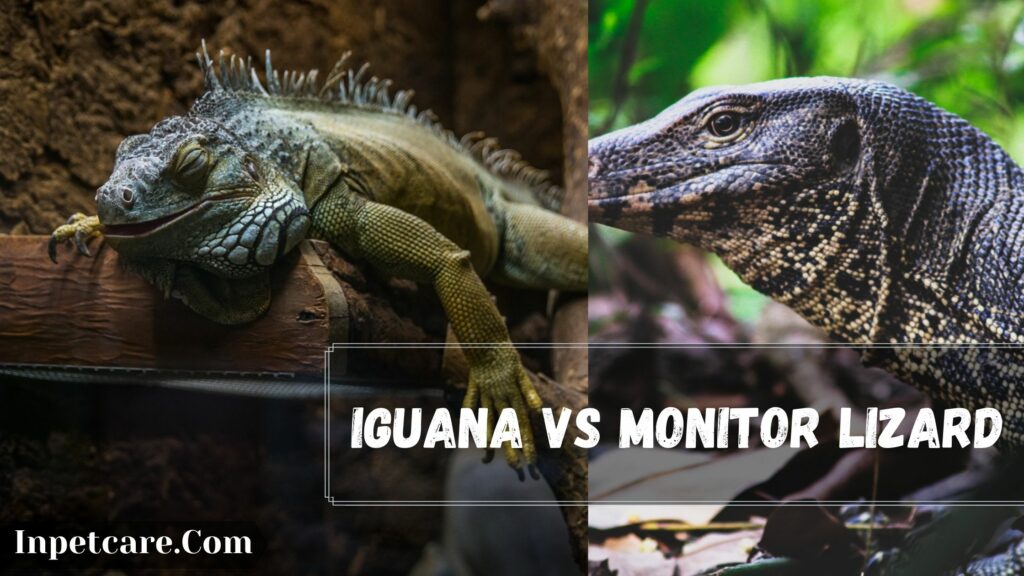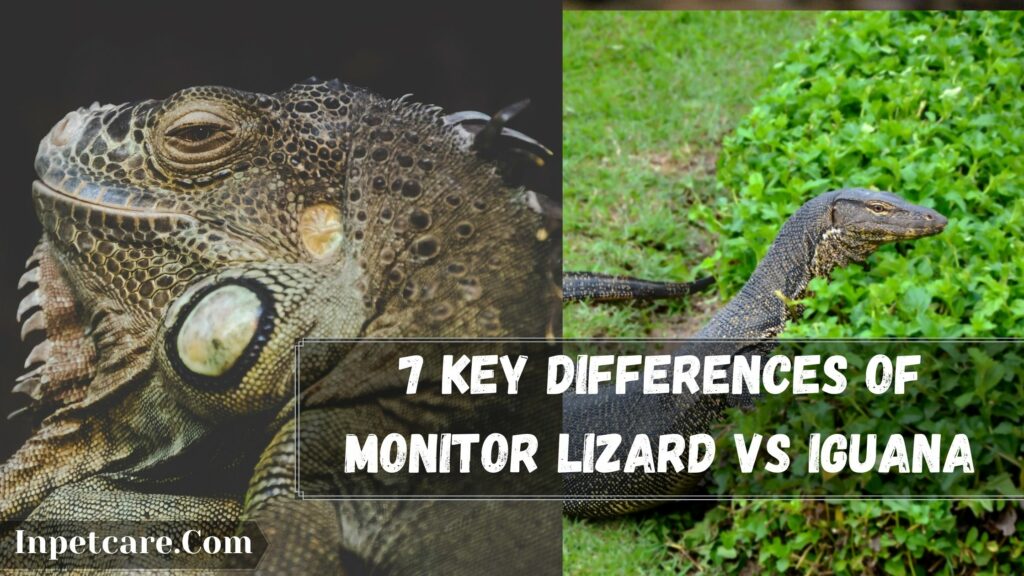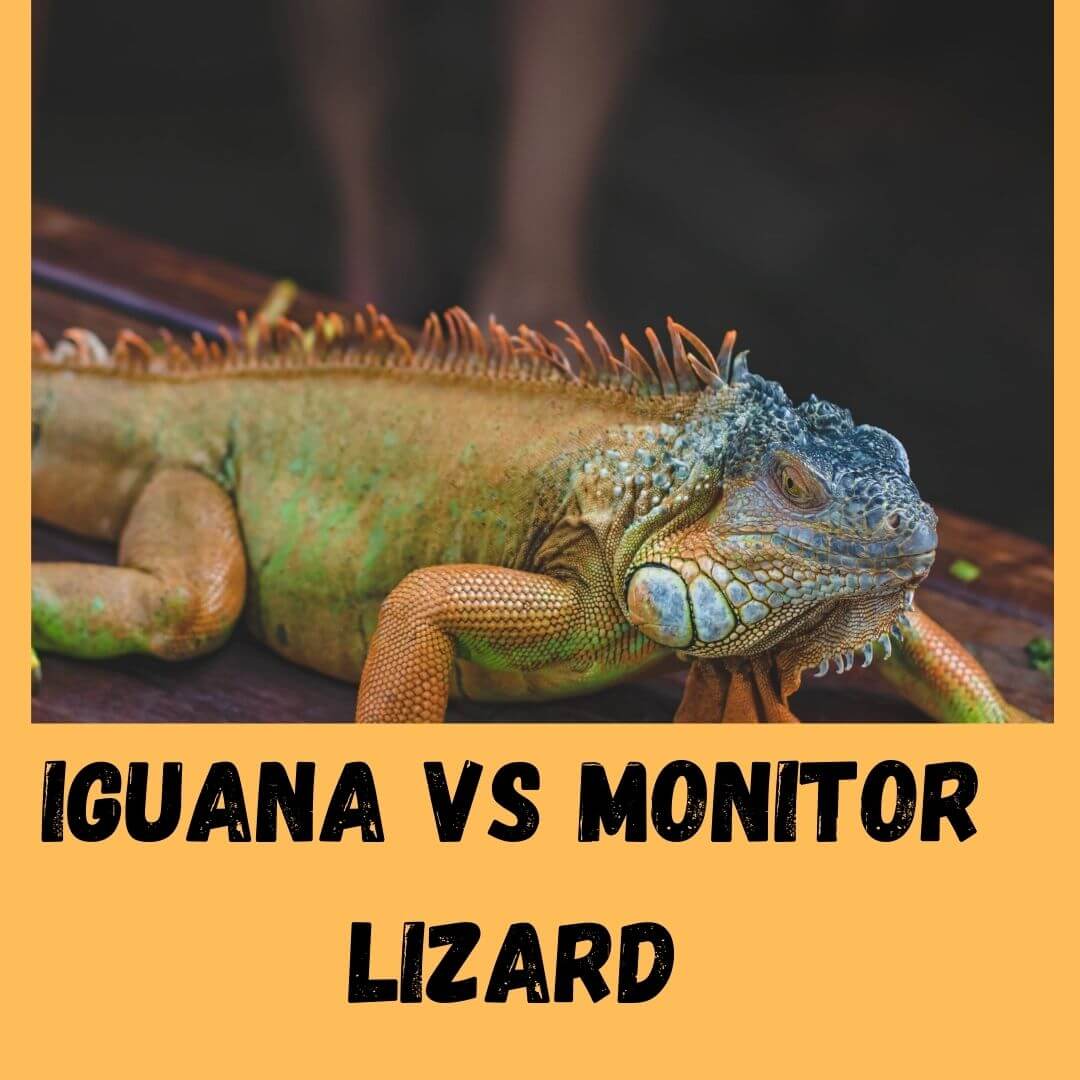There are some fascinating key differences between Iguana and Monitor Lizard. Therefore, in this article, we will learn the major differences that make them unique in their way in the wild. Normally, many species of monitor lizards live longer than the average Iguana.
Additionally, monitor Lizard species are spread in specific areas of the world. For example, Komodo dragons are monitor lizard that hails from Indonesia. However, not all monitor lizards can be termed Komodo dragons.
Hence, in this article, we will take a look at iguanas vs monitor lizard and what are the things that differ between them, apart from the monitor Lizard’s large immense size. Iguanas are popular for their small spikes spread throughout their body and the dewlap under the chin.
At the same time, most lizards don’t have such a feature. Adding to this, Iguana also turns their color from Green to Green Orange as they age. Hopefully, this article on monitor lizard vs Iguana will help you choose the right pet for you or your family.
Post Contents
Iguana Vs Monitor Lizard

Iguanas
Depending upon the species, there are a variety of scales found in iguanas that cover specific areas of their body. On the dorsal trunk of an iguana’s body, the scales tend to be more tightly packed and thicker than those on the ventral sides.
At the same time, some round tuberculate scales large in size are scattered around the neck’s lateral region overlapping smaller skills. Depending upon the type of the species of Iguana, these scales are not always recognizable from a close distance and maybe a variety of colors.
On the Iguana chick, it has round but large scales known as subtympanic shields. Adding to this, iguanas use visual signals with other lizards of the same species to communicate. They also have very clear visions, which also enable them to see colors, movements, shadows, and shapes from very long distances.
This visual ability and equity help them not only run away from predators but also to navigate through crowded forests dense with bushes and shrubs. Their Sharp vision also helps to forage for food.
Monitor Lizard
Do you know that monitor lizards carry the highest standard metabolic rate compared to all extant reptiles? They are also popular for their active pursuit hunting skills reminiscent of similar size lizards or mammals. Being highly territorial, they are known to maintain large territories to live and breed.
Also, numerous activities have been done to study these lizards’ metabolic capacities due to being highly active. Most reptiles come with a three-chamber heart, but when we talk about the nature of monitor lizards, it’s like pythons and boas’ seats.
Monitor lizards tend to have a well-developed ventricular septum. During systole, it completely separates the systemic and pulmonary sides of the circulatory system to enable quick distribution of oxygenated blood throughout the body without flooding the Iguana’s lungs with high-pressure blood.
This heart system of monitor lizards helps them create a mammalian equivalent pressure differential between the systemic circuits and the pulmonary circuits.
What do You need To Know About Iguanas?
Apart from sharp vision, iguanas also carry a parietal eye sensitive to any change in illumination. It helps them signal their pineal gland to learn and indicate the day and night cycle change. They also carry a photopigment known as parapinopsin that is sensitive to the difference between day and night.
Therefore, iguanas not only have beautiful spikes and scales on their body but also have a keen sense of eyesight that enables them to forge food, run from predators, and navigate with ease. They also use their eyes to signal and communicate with other iguanas or lizards of the same species.
Also, they are popular for shedding their tails tailor some part of that when they feel threatened by predators. In lizards’ worlds, clearing part of the tail allows them to escape easily in the wild while distracting the predators.
Do you know that the Iguana that hails from South and Central America is sometimes known as the chicken of the trees? Iguanas from Florida are known as a pest. Hence, iguanas are great swimmers; the Marine iguanas in the Galapagos Islands are great at diving and swimming away from predators. Marine Iguana usually digs their burrows near a water river bed or water sources.
What You Need To Know about Monitor lizards
One of the most intelligent lizards and reptiles is a monitor lizard that is popular for not blinking and its great vision. They are thought to be some of the most intelligent reptiles in general around the globe. With such a good vision, Monitor lizards have been seen watching the flying planes.
When kept as pets, monitor lizards can be very demanding and attention-seeking to play. They also have a very high metabolism rate, which burns energy, just like mammals. Unlike many other reptiles, you might have to give monitor lizards proper exercise.
Additionally, you are getting a very active lizard and the alert one that is a skilled Predator. It can be dangerous to keep a Monitor Lizard around similar size pets. However, as hazardous as monitor lizards might seem to smaller animals, their bite won’t be fatal to you or any humans.
7 Key Differences Of Monitor Lizard Vs Iguana

Iguana Vs Monitor Lizard: Diet
Iguanas are herbivorous, whereas monitor lizards are carnivorous. Iguanas are seen eating plants matter as they are typically folivorous. Besides that, iguanas feed almost entirely relies on the leaves of shrubs, flowering plants, trees, and vines.
They also look to provide dark green leafy vegetables and some specific fruits, including flowers. Besides that, iguanas also enjoyed commercial Iguana food and non-leafy vegetables if given in moderation. Insects or meat should never be included in an adult iguana’s diet.
Talking Monitor Lizards primarily feed on insects, fish, crabs, and snakes. Monitor lizards are great at controlling the population of their prey while, in turn, being a good source of food to predators like crocodiles or tigers.
The primary food for monitoring lizards includes small animals like pigs, deer, water buffaloes, castles, and lizards like iguanas, birds, and snakes. Some specific monitor lizards may also eat turtles and crustaceans.
Iguana Vs Monitor Lizard: Cage
Depending upon the size of the Monitor Lizard, you will need an extremely large enclosure with a minimum space of around 5ft x 4ft x 4ft. For young or baby iguanas, you can have a 20-25 gallon vivarium whereas, for adults, it is best to have a tank that is at least 12 feet long by 8 feet high as they can grow up to 6 feet in length while being more than 11 pounds.
To monitor lizards, you might also have to look at some custom made aquariums if you are preparing to bring one to your home.
Iguana Vs Monitor Lizard: Temperature
Iguanas and monitor lizards almost need the same ambient temperature in their enclosure. Their basking spot temperature should be around 94-100° F, whereas the rest area of their square should be between 80-85° F for iguanas and 85-90° F for monitor lizards.
At night, their enclosure temperature should drop to 74-78° F. When talking about Iguana, they usually thrive at high humidity levels in the enclosure, which should be around 70-75% to prevent kidney disease or infrequent/poor shedding. Monitor lizards should always have a large soaking tub that is easy to access with fresh drinking water daily.
Iguana Vs Monitor Lizard: Size
Both species are widely distributed in different lengths and sizes. Talking about Iguana, an adult Iguana can be between 4-and 5.6 feet in length from head to tail. In reality, the Iguana’s seat comprises much of its size, as the snout to vent size of the common Iguana is between 12-17 inches.
Talking about monitor lizards, some extant species can have a length of 7.9 inches to over 10 feet, depending on the type of lizard it is. If the Monitor Lizard is the Komodo dragon, expect it to grow to around 3 m. Do you know that the extinct species of monitor lizards known as megalomania were capable of reaching a length of more than 23 feet?
Iguana Vs Monitor Lizard: Appearance
Well, both being lizards, their appearance completely differs. Iguana usually has a stocky trunk with a slender tail covered with different scales. Iguanas also have a single row of the spine that starts from the neck’s nape and ends at the tip of their seats.
On the other hand, Monitor Lizard is also covered with scales but differs in color. Their scale color can range from green, tan, brown, or grey in some cases. Also, On either side of the Iguana head is an eye with round pupils and movable lids, whereas monitor lizards have very large bodies with powerful tails and long necks.
Do you know that monitor lizard also have long tongues like snakes that are forked? They are also great at predating with their strong claws and well-developed limbs.
Interesting Further Reading
Iguana Vs Monitor Lizard: Life Expectancy
Interestingly, monitor lizards are capable of living more than any Iguana. The average life expectancy of a healthy Iguana is 12-20 years.
On the other hand, monitor lizards can easily supersede that and live more than 20 years. The average lifespan of a Monitor Lizard is 8-30 years.
Iguana Vs Monitor Lizard: As Pets
Talking about keeping them as pets, both lizards can make an excellent pet for the right person. However, holding and petting a Monitor Lizard will be a completely different experience than having a pet like a cat or a dog.
As pets, monitor lizards need patience, adequately caring, and learning new skills from their owners. Iguana is great as a pet for any reptile lover who can afford these exotic creatures. If you know how to take care of reptiles and are okay with the thought of caring for them, they can make great pets for anyone.
With any of these, you will need to do proper research and get prepared with the necessary equipment required to keep them protected and healthy. Before buying any of these, I would recommend you consult with an existing reptile owner to learn about the care of iguanas and monitor lizards.
Conclusion
You have all the information needed to decide which one is suitable to keep as a pet for you and your family. From my research and perspective, I would recommend you first adopt an easy to care reptile or if you don’t want to, then go with the Iguana in the first place.
Iguanas are relatively easy to take care of when compared with monitor lizards. Monitor lizards will need not only large space to thrive but also proper attention from you. You will need to devote time to keeping them healthy and on appropriate mental stimulation.
On the other hand, Iguanas are relatively easy to maintain due to their specific requirement that doesn’t frequently change with time. Whatever pet you get, be ready to devote a lot of time as bringing any of these is a long-term commitment.
I have tried my best to give you all the Iguana vs monitor lizard information. If you like our post, share it with others to help them know what is better between these two as pets. Hence, both are extremely rare and beautiful creatures around the world. See you in another article, till then take care and goodbye.

94% of pet owners say their animal pal makes them smile more than once a day. In 2007, I realized that I was made for saving Animals. My father is a Vet, and I think every pet deserves one. I started this blog, “InPetCare”, in 2019 with my father to enlighten a wider audience.
